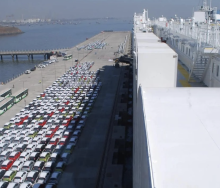South Africa’s ports handled an average of 8 281 containers per day last week, significantly up from the 6 180 that had been recorded by the previous Cargo Movement Update compiled by the Southern African Association of Freight Forwarders (Saaff) and Business Unity South Africa (Busa).
As was the case with data gathered for the previous Update, reflecting the impact of inclement conditions on the country’s coast, “port operations this week were again widely disrupted by adverse weather and increasing equipment breakdowns and shortages,” Saaff and Busa found.
“However, performance was much better compared with last week.
“This week's primary operational constraint in Cape Town stemmed from the dense fog, while adverse weather coupled with equipment breakdowns and shortages caused extensive delays in Durban.
Strong winds and dense fog also hampered operational performance at ports in the Eastern Cape, notably the Port of Ngqura where shipping line representatives raised concerns regarding equipment challenges.
“Additionally, the latest reports suggest that Transnet Freight Rail experienced network issues for about six hours in the Durban complex between Tuesday and Wednesday.”
Looking at global dynamics, the Update reports that its analysis shows how manufacturing's contribution to GDP has declined across major African economies due to various challenges.
Nestlé's closure of its Nesquik production in South Africa, Unilever's halt in Nigeria, and outsourcing by Bayer and GSK in Kenya and Nigeria exemplify this trend.
“Despite initial enthusiasm from multinationals attracted by growth and youthful populations, challenges like currency fluctuations, bureaucracy, power shortages, and congested ports have dampened investment appeal.
“Container trade statistics for February show a significant monthly decrease, mainly due to the Chinese New Year and compounded by crises like those in the Red Sea and (the drought affecting the canal in) Panama.”
It is hoped that water level problems at the Gatun Lake locks will soon be alleviated through predictions of incoming downpours in Panama, reports from elsewhere have indicated.
“In Sub-Saharan Africa, imports remained up compared with February last year, while exports steadily grew by 22.1%.
“However, South Africa's share of regional container trade has declined, diminishing its role as Africa's primary maritime entry point.
“Despite increased container deliveries, demand for cargo remains strong, with charter rates climbing, driven partly by crises in the Middle East and Suez diversions.
“Global port congestion affects about 5.9% of the total fleet, with Durban experiencing congestion, while idle capacity stands at approximately 0.4%.”
Saaff and Busa say other developments in containerised shipping include the general average that was declared in the matter of the Dali, the box ship that allided with a long-span truss bridge south of the Port of Baltimore in the US.
It is furthermore hoped that the Panama Canal Authority, envisaging a return to regular service levels, will soon find data reflection in an increase of volume throughput.













